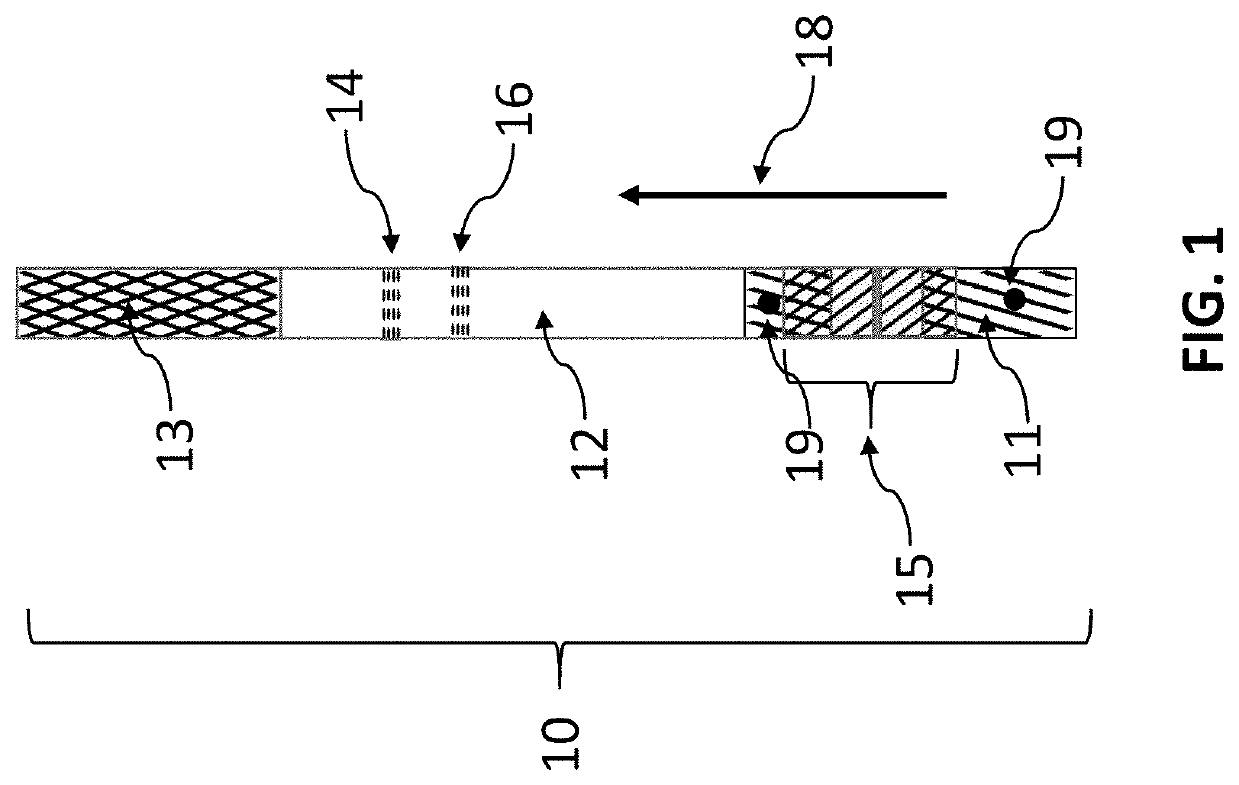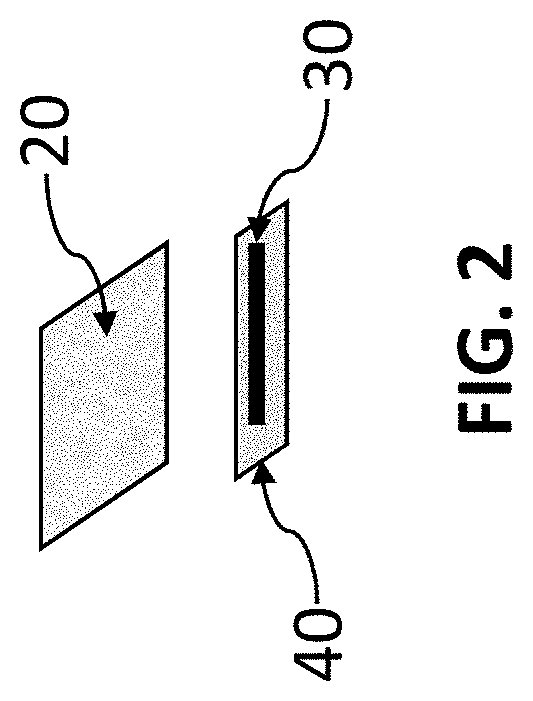Delay process to provide timed chemistry to lateral-flow immunoassays
a technology of immunoassay and lateral flow, which is applied in the direction of instruments, color/spectral properties measurements, material analysis, etc., can solve the problems of increasing the size of the nanoparticle label, limited sensitivity of lfias, and insufficient sensitivity for some applications, so as to achieve simple use and improve sensitivity
- Summary
- Abstract
- Description
- Claims
- Application Information
AI Technical Summary
Benefits of technology
Problems solved by technology
Method used
Image
Examples
example 1
[0033]Two fibers are used as fiber 30. One is impregnated with a hydrogen peroxide precursor that releases hydrogen peroxide upon exposure to water. The second fiber (not shown in FIG. 1) is impregnated with two dye precursors that are for precipitating dye in the presence of a catalyst. This example uses catalyst dye chemistry impregnated on the second fiber as outlined by Kidwell (Kidwell, “Catalytic Particles for Increased Sensitivity in Lateral Flow Immunoassays,” United States Patent Application 20180052153, Feb. 22, 2018 and Kidwell et al., “Catalytic Particles For Signal Enhancement For Lateral Flow Immunoassays,” United States Patent Application 20190339265, Nov. 7, 2019).
[0034]The second fiber was prepared by soaking cotton twine (average 225 μm diameter) in a solution of 40 mg / mL 4-Hydroxy-1-naphthalenesulfonic acid sodium salt (CAS #6099-57-6), 30 mg / mL N,N-Diethyl-p-phenylenediamine (CAS #6283-63-2), and 20 mg / mL citric acid (CAS #77-92-9) in equal parts ethanol and wate...
example 2
[0039]A method to easily visualize the working of the chemical release fiber construct 15 is to use precursors that form a dye upon reaction with a catalyst. It is especially useful to use precursors for the reaction of hydrogen peroxide in the presence of a palladium catalyst. Fiber 30 was constructed as in Example 1. Five different types of chemical release fiber constructs 15, done in triplicate, were constructed with different membranes 40. The constructs were placed on the nitrocellulose strip 12. The average time to just start the development of the line at the catalyst are shown in Table 1 for various chemical release fiber constructs 15. As can be seen in Table 1, the time can be varied over a long period though simply changing the membrane or the number of layers.
TABLE 1Time to just observe the start of dye formation. The running solution was 1% hydrogen peroxide in 100 mM sodium carbonate buffer. The catalyst was sprayed at approximately 30 ng / line.Construct of Time to Sta...
example 3
[0040]An additional method to easily visualize the working of the chemical release fiber construct 15 is to use colored dyes. It is especially useful to use anionic dyes as they have less affinity for the components of the chemical release fiber construct 15 and the lateral-flow immunoassay construct 10. pH sensitive dyes such as bromophenol blue are preferred as they change color form yellow to blue on a pH shift. The dye is loaded in fiber 30 in acid media and dried, the fiber will be yellow in color. If the test solution were basic, the rate of hydration of the fiber can be readily measured by the color change. Likewise, the release of the now blue dye into the flowing stream on nitrocellulose 12 can be easily visualized.
[0041]FIG. 7A is a photograph of a chemical release fiber construct 15 directly on nitrocellulose 12 after the interior fiber 20 has just been hydrated. FIG. 7B is a photograph of a chemical release fiber construct 15 directly on nitrocellulose 12 during the rele...
PUM
 Login to View More
Login to View More Abstract
Description
Claims
Application Information
 Login to View More
Login to View More - R&D
- Intellectual Property
- Life Sciences
- Materials
- Tech Scout
- Unparalleled Data Quality
- Higher Quality Content
- 60% Fewer Hallucinations
Browse by: Latest US Patents, China's latest patents, Technical Efficacy Thesaurus, Application Domain, Technology Topic, Popular Technical Reports.
© 2025 PatSnap. All rights reserved.Legal|Privacy policy|Modern Slavery Act Transparency Statement|Sitemap|About US| Contact US: help@patsnap.com



